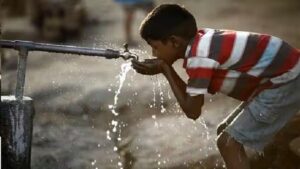GS II-Governance

Context:
India is facing an escalating water crisis due to rising temperatures, with 2024 recorded as the hottest year since 1901. The intensifying heatwaves have further widened the water availability gap, leading to severe resource stress.
Understanding the Water Gap:
The water gap signifies the imbalance between the renewable water supply and its consumption within a given region. When demand surpasses availability, it results in unsustainable water usage and depletion of resources.
Heatwaves and Water Scarcity: Key Insights
- 2024 marked the hottest year in India since 1901, with January 2025 witnessing a 0.9°C temperature rise compared to the previous year.
- Heatwaves claimed 733 lives in 2024, intensifying the pressure on water supplies.
- Under a 1.5°C global temperature increase, India’s water deficit is expected to grow by 11.1 cubic km/year, worsening to 17.2 cubic km/year at 3°C warming.
Key Factors Contributing to the Widening Water Gap:
- Climate Change Impact:
- Rising global temperatures alter rainfall patterns, resulting in reduced precipitation and prolonged droughts.
- Example: India recorded its highest-ever temperatures in 2024, leading to water shortages across multiple states.
- Overexploitation of Groundwater:
- Excessive withdrawal for irrigation, industrial expansion, and urban development is depleting underground reserves.
- Example: India contributes to 25% of the world’s groundwater extraction, and 21 major cities are expected to exhaust their groundwater reserves by 2030.
- Rapid Population Growth & Urbanization:
- The increasing urban population and industrial demands have intensified pressure on water resources.
- Inefficient Water Management:
- Poorly maintained water infrastructure and high wastage rates exacerbate the crisis.
- Example: Only 8% of India’s wastewater is treated, leading to wastage and contamination of water sources.
- Water Pollution:
- Industrial discharge and agricultural runoff severely pollute rivers and lakes, reducing usable freshwater reserves.
- Example: The Central Pollution Control Board reports that 75% of India’s rivers are unsuitable for drinking due to pollution.
Consequences of the Water Gap:
Agricultural Crisis:
- Declining irrigation water availability lowers crop yields, threatening food security and farmer incomes.
- Example: In 2024, drought-like conditions affected 60% of Indian districts, leading to higher food prices.
Health Hazards:
- Water scarcity leads to poor sanitation, increasing outbreaks of waterborne diseases.
- Example: Over 163 million Indians lack access to clean drinking water, contributing to 21% of communicable diseases.
Economic Disruptions:
- Industries relying on water face production halts, causing financial setbacks.
Environmental Degradation:
- Overuse of rivers, lakes, and wetlands threatens biodiversity and aquatic ecosystems.
- Example: The Ganga-Brahmaputra Basin, which houses 10% of the world’s biodiversity, is experiencing a water deficit of 56.1 cubic km/year.
Strategies to Address the Water Crisis:
Adopting Sustainable Water Practices:
- Promote efficient irrigation techniques and rainwater harvesting to enhance conservation.
- Example: Tamil Nadu’s mandatory rainwater harvesting policy improved urban groundwater levels by 50%.
Strengthening Policy Measures:
- Enforce strict regulations on groundwater extraction to prevent overuse.
Infrastructure Development:
- Build reservoirs, check dams, and recharge wells to improve water storage and distribution.
- Example: The Jal Shakti Ministry reported a 15 billion cubic meter increase in groundwater recharge in 2024 due to government initiatives.
Public Awareness Initiatives:
- Educate citizens about water conservation methods and responsible usage.
Climate Adaptation Strategies:
- Develop resilient policies to combat the effects of rising temperatures on water resources.
- Example: India’s National Action Plan on Climate Change prioritizes sustainable water resource management.
Conclusion:
Water scarcity remains one of India’s most pressing environmental and developmental challenges. Urgent policy reforms, sustainable water management, and public participation are crucial in addressing this crisis. A proactive approach can help bridge the water gap, ensuring future water security for India.




